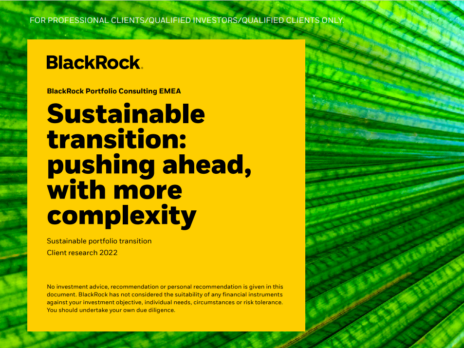
The majority of investors who are choosing indexed exposures to build their sustainable portfolios are currently following Socially Responsible Investing (SRI) indices. According to figures from BlackRock, 93% of sustainable indexed fixed income UCITS exchange traded funds (ETF) AUM are tracking these type of indices.

Market conditions can amplify differences in risk and returns between SRI indices and their parent non-sustainable indices. An understanding of these dynamics, and having the right analytical tools, will be important to investors who seek to improve their fixed-income sustainability profile while achieving desired portfolio outcomes, such as targeting a set yield level or duration profile.
Fixed-income ETFs: implementation with indexing
In particular, the proliferation of index-tracking sustainable fixed-income ETFs is giving investors rules-based methodologies that provide transparency, accessibility, liquidity and efficiency.
Sustainable investing has been around for years in equity markets, but the practice is a more recent addition to the fixed-income landscape. Index-tracking sustainable fixed-income ETFs have particular appeal: they are low-cost and liquid, and they track indices that provide visibility into which bonds are eligible based on criteria such as ESG ratings, exposure to controversial activities and carbon intensity.
In a short period of time, responsible investing has become a popular practice in the fixed-income universe, as evidenced by the phenomenal growth the asset class has undergone. The number of global assets invested in sustainable fixed-income ETFs has dramatically expanded from year to year. In fact, research from BlackRock and Morningstar found that in the seven years from January 2015 to December 2021 investment in these more sustainable instruments increased by 3,682% (from $1.4bn in January 2015 to $50bn in December 2021). This compares with an increase of 403% in traditional fixed-income ETFs (from $436bn in January 2015 to $1.8trn in December 2021).
Understanding drivers of risk and return in sustainable bond portfolios
ETFs and index funds offer several benefits when it comes to integrating sustainability in fixed-income allocations. These funds track indices that are built utilising a rules-based approach, giving investors clear visibility into the sustainable criteria for bond inclusion from independent specialist data providers. Sustainable fixed-income ETFs and index funds can be cost-effective and transparent, offering a daily look at a fund’s ESG composition and characteristics.
These features make sustainable fixed-income ETFs and index funds effective tools for incorporating sustainability considerations in a consistent way across the whole portfolio. BlackRock believes this is a process that starts with a clear understanding of the existing characteristics of your bond portfolio and the subsequent risk and return implications associated with the switch to sustainable alternatives. A sustainable fixed-income portfolio’s risk and return is determined by the same drivers that impact a typical, non-sustainable portfolio, such as duration and credit quality.
Understanding these drivers of risk and return is key to building a sustainable fixed-income portfolio that meets an investor’s goals. BlackRock research suggests that when analysed over a longer period, a sustainable fixed-income portfolio has been shown to exhibit improved overall portfolio resiliency, sustainable profile improvements, and potentially lower overall portfolio risk. Investors can manage the differing risk characteristics at an asset allocation level by making some adjustments to ensure their portfolio remains aligned with their desired investment outcomes, along with their sustainability goals.
Incorporating sustainability: resilience and impact
An essential step in achieving desired portfolio outcomes is developing an understanding of sustainable fixed-income index characteristics – and importantly, what is driving returns. While it might stand to reason that explicit sustainable characteristics drive returns, BlackRock analysis demonstrates that sustainable fixed-income index returns are driven by the same risk and return variables as their traditional counterparts. In other words, risk and return drivers such as credit quality and duration drive returns in sustainable fixed-income indices just as they do for their parent indices.
Despite the same characteristics driving returns, there may be considerable return differences between sustainable fixed-income indices and their parent indices. It is important to recognise that it is not sustainable characteristics driving these differences – rather, it is differentiation in the fixed-income characteristics themselves. BlackRock’s research has evidenced that the impact of sustainable characteristics on bond prices remains small, with a lack of stable relationships over time and no significant price differential for higher ESG-rated issuers. BlackRock continues to monitor this dynamic and its impact on performance differentials between sustainable and non-sustainable indices.
Sustainable fixed-income indices differentiated returns may be attributed to these distinct fixed-income risk and return drivers. In the tables above, the Bloomberg MSCI US Corporate Sustainable SRI Index exhibits lower duration and yield-to-maturity than its non-sustainable counterparts (Bloomberg US Aggregate Corporate Bond Index and Markit iBoxx USD Liquid Investment Grade Index); however, these drivers of return may vary across time periods.
In general, the extent to which a particular fixed-income risk and return component explain returns is market regime-dependent. For example, during periods of rising interest rates, duration is a larger driver of returns. During risk-on or risk-off periods, credit rating primarily explains returns and the greater resiliency investors achieve in risk-off markets when holding sustainable exposures.
Deliberate focus on the risk and return drivers in a sustainable fixed-income portfolio enables greater control and helps avoid unintended outcomes. In the next article in this series, we will look in more depth at implementation considerations when integrating sustainability in fixed-income portfolios.
Index performance returns do not reflect any management fees, transaction costs or expenses. Indices are unmanaged and one cannot invest directly in an index. This information should not be relied upon as research, investment advice, or a recommendation regarding any products, strategies, or any security in particular. This is for illustrative and informational purposes and is subject to change. It has not been approved by any regulatory authority or securities regulator. The ESG considerations discussed herein may affect an investment team’s decision to invest in certain companies or industries from time to time. Results may differ from portfolios that do not apply similar ESG considerations to their investment process.
The benchmark index only excludes companies engaging in certain activities inconsistent with ESG criteria if such activities exceed the thresholds determined by the index provider. Investors should therefore make a personal ethical assessment of the benchmark index’s ESG screening prior to investing in the Fund. Such ESG screening may adversely affect the value of the Fund’s investments compared to a fund without such screening.
This document is marketing material: Before investing, please read the Prospectus and the KIID available on www.ishares.com/it, which contain a summary of investors’ rights.







